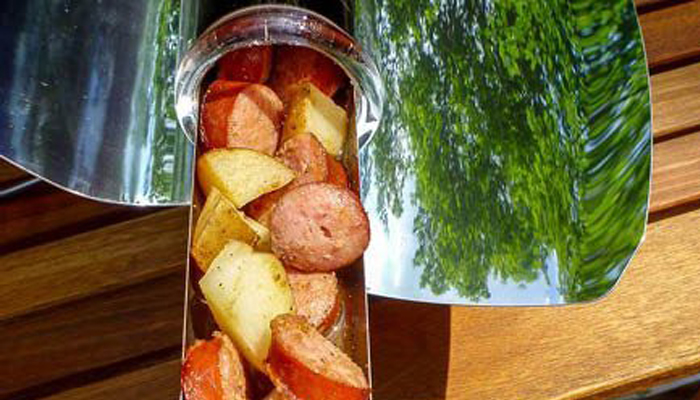
If you were to set a hamburger patty or a hot dog, for example, in direct sunlight on your back deck railing, it would not cook, they would thaw out, of course, if frozen, but eventually spoil before the cooking process even began, so then how does a solar oven work to get your foods cooked?
First, a solar oven lets in UV rays and then converts those rays into infrared light that stays contained inside a cooking chamber. UV light enters but infrared light cannot escape, and so it will bounce around inside the chamber heating it up. This action is similar to how microwave ovens work. The action vibrates the water, fat, and protein inside of foods. This rapid motion or agitation is what creates heat. Solar ovens or stoves will have reflectors, a shiny metal similar to aluminum foil or even mirrors attached that direct the sun’s rays onto the cooking chamber.
Sounds complicated, but it is not by any means. The inside of your car or a greenhouse is essentially heated the same way when there is ample sunlight.
You can make your own solar oven or buy one ready to go out of the box. To make your own you would need a cooking chamber and a black heavy metal pot would be one example of a cooking chamber. You could use oven cooking bags inside the pot to trap heat around the foods. You would place your foods in the bags or some similar container. Around the outside, you would place reflective material to direct sunlight onto the black container. Having a lid on the pot or kettle would help trap the heat inside.
Solar ovens are more advanced than they were just a few years in the past, but keep in mind they are not like your oven at home. Several factors will affect how fast your foods are cooked. Placement of the oven is one factor, the density and how much food is placed inside is another factor. The ambient temperature does have an effect, but is not a major factor as to whether your foods cook or not.
For those of you interested in purchasing a solar oven ready to go out of the box let’s take a look at two popular commercially available sun ovens, the GoSun Sport and the All American Sun Oven.
The GoSun Sport might be the easiest to understand. It consists of two mirrors and a chamber made of evacuated Pyrex. When unfolded and ready to cook, you will notice the two mirrors are parabolic mirrors. These curved mirrors focus the sun’s energy on the insulated tube, sort of like how a magnifying glass works, but in reverse. Once the light enters the chamber it is converted to heat, and this heat has to leave the chamber through conduction as opposed to radiating. Long story short, because of the insulated Pyrex, it cannot escape fast enough and it builds up. The GoSun Sport is a very efficient design, but because it emphasizes efficiency over functionality, you have to cut up your food to fit in the tube.
The All American Sun Oven uses the same principles, but is a less efficient design. It uses reflectors to concentrate the heat. The light passes through the glass on top, hits the black walls of the cooking chamber, and is converted to infrared heat. While being less efficient than the GoSun, it does have an advantage in that it can cook meals more traditionally, you don’t have to cut up portions small enough to fit in a tube.
Once you unpack your oven, you will need to read the directions carefully. Keep in mind, however, the cooking times listed in the manuals are times under ideal conditions, and often times, the conditions are simulated inside of testing labs.
This does not mean your oven will not work, because in reality if the all of the components are there, then there is no way the solar oven cannot work if it is set in direct sunlight. The cooking times will vary as stated earlier, so do not assume your oven is defective if it takes 10 or even 20 minutes longer than what the manual states to cook specified food items.
You can bake foods, such as cakes, brownies and bread, and you can even dehydrate foods inside of some ovens. Dehydration or the drying out of foods requires steady heat for a certain period, and it requires space and a certain configuration, however. If you want this feature built in, then make sure you buy a solar oven that specifically states you can dehydrate using it otherwise; you may not be as successful as you want.
Dehydration requires the venting of moisture, so research before buying to make sure the oven you want has all the features needed.
Take your solar oven camping, fishing or hunting and even hiking if you get a small enough model so it fits comfortably in your pack.